Ansible automatic operation and maintenance tool - module and host list
3, ansible command line module
1, Ansible overview
Ansible is a configuration management and application deployment tool developed based on Python. It is also shining in the field of automatic management. It combines the advantages of many old operation and maintenance tools. Ansible can basically realize the functions that Pubbet and Saltstack can achieve.
Ansible can batch configure, deploy and manage thousands of hosts. For example, for one or more operations that need to be switched to each host before, using ansible only needs to complete the operations of all hosts on a fixed ansible control node.
Ansible works based on modules. It only provides a running framework. It does not have the ability to complete tasks. Ansible's modules actually perform operations. For example, the copy module is used to copy files to the remote host, and the service module is used to manage the start, stop and restart of services.
One of the distinctive features of Ansible is Agentless, that is, there is no Agent. Like ordinary commands, Ansible is not C/S software, and it only needs to be installed once on a host as a control node. Usually, it controls the remote host based on ssh connection, and Ansible or other additional services do not need to be installed on the remote host.
When the user inputs a command or playbooks at the server terminal, the playbook will be disassembled into play through the predetermined rules, and then organized into tasks that can be recognized by ansible, call modules and plug-ins, send the temporary file to the remote client through SSH according to the host list, execute and return the results, and automatically delete it after execution.
Another distinctive feature of Ansible is that most of its modules have idempotence. Idempotency means that multiple operations or multiple executions have the same impact on system resources. For example, execute the systemctl stop xxx command to stop the service. When it is found that the target service to be stopped is already stopped, it will do nothing. Therefore, the result of multiple stops is still stop and will not change the result. It is idempotent, while systemctl restart xxx is non power.
Many Ansible modules will first judge whether the target node wants to execute a task when executing. Therefore, you can safely and boldly let Ansible execute a task. Repeated execution of a task will not produce any side effects most of the time.
2, ansible deployment
---------- ansible Environment installation and deployment ---------- Management end: 192.168.30.17 ansible Managed end: 192.168.30.18 Managed end: 192.168.30.19 //Management side installation ansible yum install -y epel-release //Install the epel source first yum install -y ansible //ansible directory structure /etc/ansible/ ├── ansible.cfg #The configuration file of ansible generally does not need to be modified ├── hosts #ansible host list, which is used to store information about remote hosts to be managed └── roles/ #Public role directory //Configure host list cd /etc/ansible vim hosts [webservers] #Configuration group name 192.168.30.18 #IP address or host name of the managed host contained in the group (the host name needs to modify the / etc/hosts file first) [dbservers] 192.168.30.19 //Configure key pair authentication ssh-keygen -t rsa #Enter all the way and log in without secret sshpass -p 'abc1234' ssh-copy-id root@192.168.30.18 sshpass -p 'abc1234' ssh-copy-id root@192.168.30.19
Example:


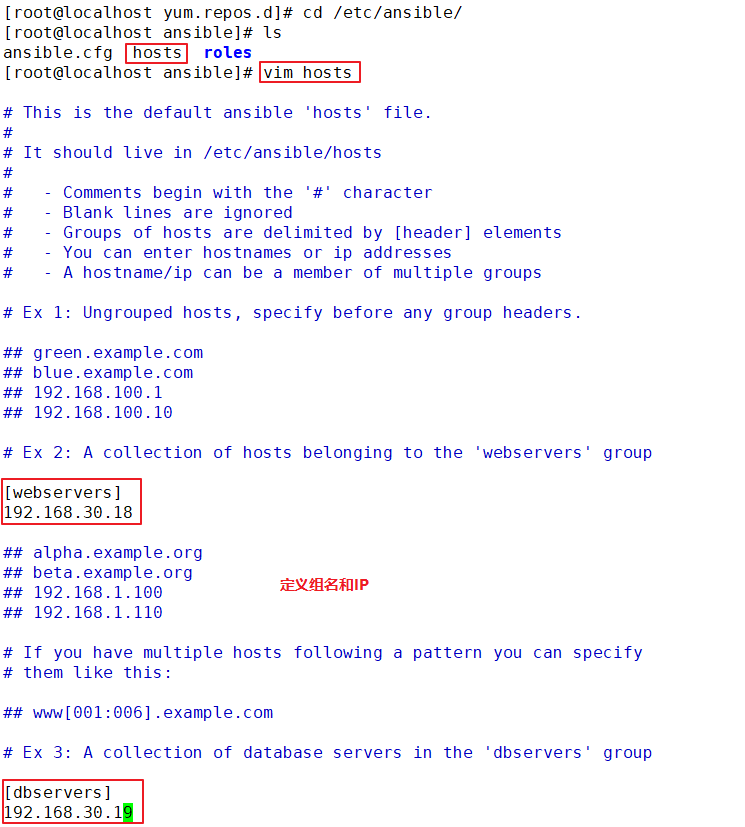
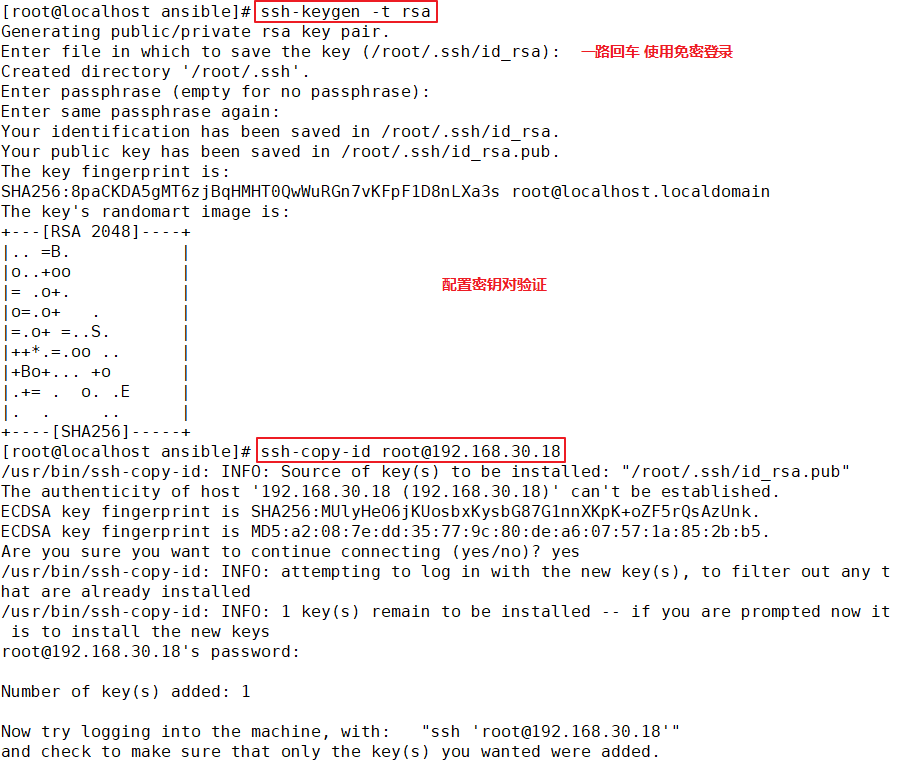
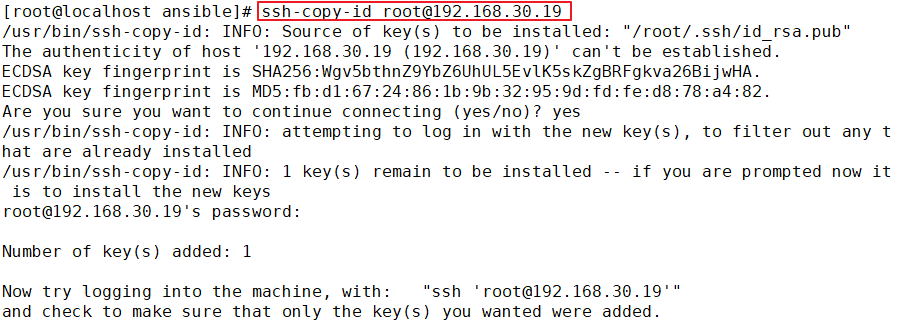
3, ansible command line module
--------- ansible Command line module ---------
Command format: ansible <Group name> -m <modular> -a <parameter list>
ansible-doc -l #List all installed modules and press q to exit
1.command modular
//Executing commands on the remote host does not support shell features such as pipeline and redirection.
ansible-doc -s command #-s lists the description information and operation actions of the specified module
ansible 192.168.30.18 -m command -a 'date' #Specify ip execution date
ansible webservers -m command -a 'date' #Specify group execution date
ansible dbservers -m command -a 'date'
ansible all -m command -a 'date' #All stands for all hosts
ansible all -a 'ls /' #If the - m module is omitted, the command module is run by default
//Common parameters:
chdir: Enter the directory in advance before running the command on the remote host
creates: Judge whether the specified file exists. If so, do not perform the following operations
removes: Judge whether the specified file exists. If so, perform the following operations
ansible all -m command -a "chdir=/home ls ./"
2.shell modular
//Executing commands on the remote host is equivalent to calling the shell process of the remote host, and then opening a sub shell under the shell to run commands (supporting functions such as pipe symbols)
ansible-doc -s shell
ansible dbservers -m shell -a 'echo 123456 | passwd --stdin test"'
ansible dbservers -m shell -a 'echo $(ifconfig ens33 | awk "NR==2 {print $2}") | cut -d " " -f2'
ansible dbservers -m shell -a 'echo $(ifconfig ens33 | awk "NR==2 {print \$2}")'
3.cron modular
//Define a task schedule on the remote host. There are two state s: present means add (can be omitted), and absent means remove.
ansible-doc -s cron #Press q to exit
//Common parameters:
minute/hour/day/month/weekday: branch/Time/day/month/week
job: Task plan commands to execute
name: Name of the task schedule
ansible webservers -m cron -a 'minute="*/1" job="/bin/echo helloworld" name="test crontab"'
ansible webservers -a 'crontab -l'
ansible webservers -m cron -a 'name="test crontab" state=absent' #Remove the planned task. If the planned task does not have a name, name=None
4.user modular
//User management module
ansible-doc -s user
//Common parameters:
name: User name, required parameter
state=present|absent: Create an account or delete an account, present Indicates creation, absent Indicates deletion
system=yes|no: Is it a system account
uid: user uid
group: User basic group
shell: Used by default shell
move_home=yse|no: If the set home directory already exists, do you want to move the existing home directory
password: The password of the user. It is recommended to use the encrypted string
comment: User's comment information
remove=yes|no: When state=absent Delete user's home directory
ansible dbservers -m user -a 'name="test01"' #Create user test01
ansible dbservers -m command -a 'tail /etc/passwd'
ansible dbservers -m user -a 'name="test01" state=absent' #Delete user test01
5.group modular
//User group management module
ansible-doc -s group
ansible dbservers -m group -a 'name=mysql gid=306 system=yes' #Create mysql group
ansible dbservers -a 'tail /etc/group'
ansible dbservers -m user -a 'name=test01 uid=306 system=yes group=mysql' #Add test01 user to mysql group
ansible dbservers -a 'tail /etc/passwd'
ansible dbservers -a 'id test01'
6.copy modular
//Used to copy the specified host file to the remote host
ansible-doc -s copy
//Common parameters:
dest: Point out the target and location of the copied file, and use the absolute path. If it is the source directory, it means that the target directory is also the directory. If the target file already exists, the original content will be overwritten
src: Indicates the path of the source file. Relative path or absolute path can be used. Direct directory assignment is supported. If the source is a directory, the target is also a directory
mode: Indicates the permissions of the target file when copying
owner: Indicates the owner of the target file when copying
group: Indicates the group to which the target file belongs when copying
content: Indicates that the content copied to the target host cannot be the same as src Use together
ansible dbservers -m copy -a 'src=/etc/fstab dest=/opt/fstab.bak owner=root mode=640'
ansible dbservers -a 'ls -l /opt'
ansible dbservers -a 'cat /opt/fstab.bak'
ansible dbservers -m copy -a 'content="helloworld" dest=/opt/hello.txt' #Write helloworld to the / opt/hello.txt file
ansible dbservers -a 'cat /opt/hello.txt'
7.file modular
//Set file properties
ansible-doc -s file
ansible dbservers -m file -a 'owner=test01 group=mysql mode=644 path=/opt/fstab.bak' #Modify the file's primary group permissions, etc
ansible dbservers -m file -a 'path=/opt/fstab.link src=/opt/fstab.bak state=link' #Set / opt/fstab.link to the link file of / opt/fstab.bak
ansible dbservers -m file -a "path=/opt/abc.txt state=touch" #Create a file
ansible dbservers -m file -a "path=/opt/abc.txt state=absent" #Delete a file
8.hostname modular
//Used to manage host names on remote hosts
ansible dbservers -m hostname -a "name=mysql01"
9.ping modular
//Detect connectivity of remote hosts
ansible all -m ping
10.yum modular
//Installing and uninstalling packages on remote hosts
ansible-doc -s yum
ansible webservers -m yum -a 'name=httpd' #Installation services
ansible webservers -m yum -a 'name=httpd state=absent' #Uninstall service
11.service/systemd modular
//Used to manage the running state of the management service on the remote host
ansible-doc -s service
//Common parameters:
name: Managed service name
state=started|stopped|restarted: Actions include startup, shutdown or restart
enabled=yes|no: Indicates whether to set the service to start automatically
runlevel: If set enabled To enable and disable automatic startup, you need to define which operation targets are automatically started
ansible webservers -a 'systemctl status httpd' #View the running status of web server httpd
ansible webservers -m service -a 'enabled=true name=httpd state=started' #service httpd start
12.script modular
//Realize remote batch running of local shell scripts
ansible-doc -s script
vim test.sh
#!/bin/bash
echo "hello ansible from script" > /opt/script.txt
chmod +x test.sh
ansible webservers -m script -a 'test.sh'
ansible webservers -a 'cat /opt/script.txt'
13.setup modular
//The facts component is used to collect the managed node information, which can be obtained by using the setup module
ansible-doc -s setup
ansible webservers -m setup #Get facts information of mysql group host
ansible dbservers -m setup -a 'filter=*ipv4' #Filter can be used to filter the specified facts information
Example:
command module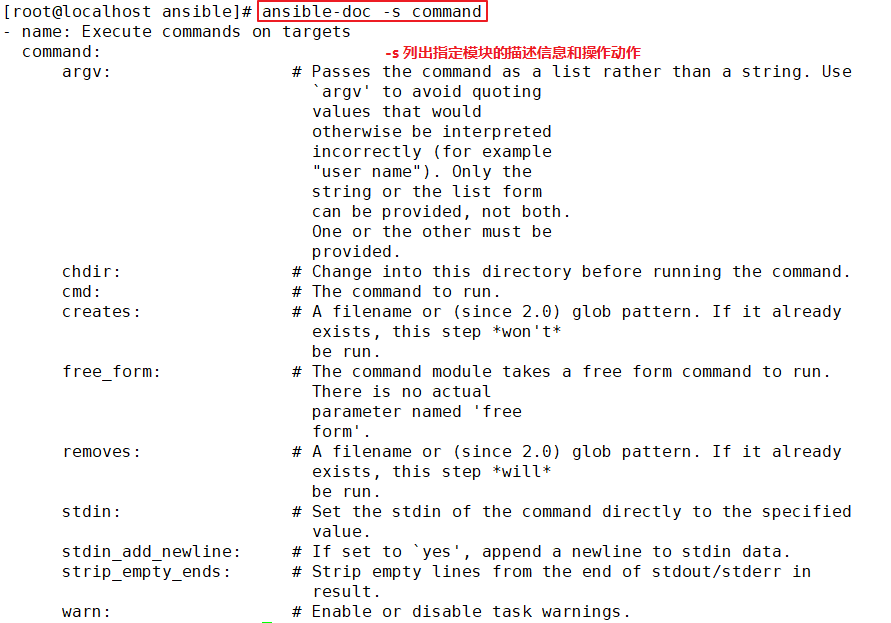
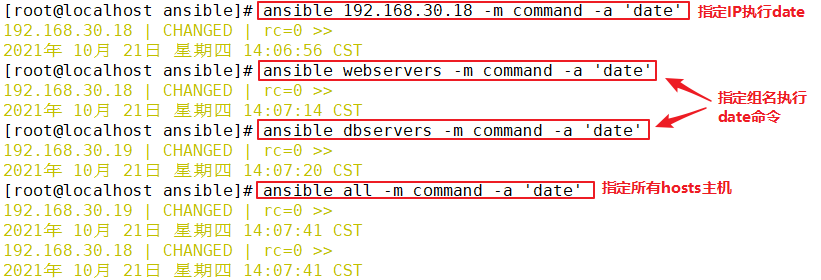
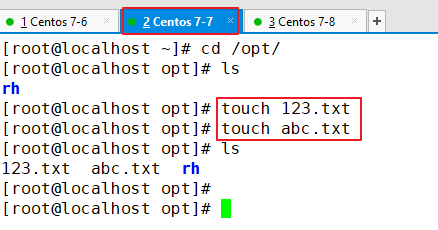

shell module


cron module
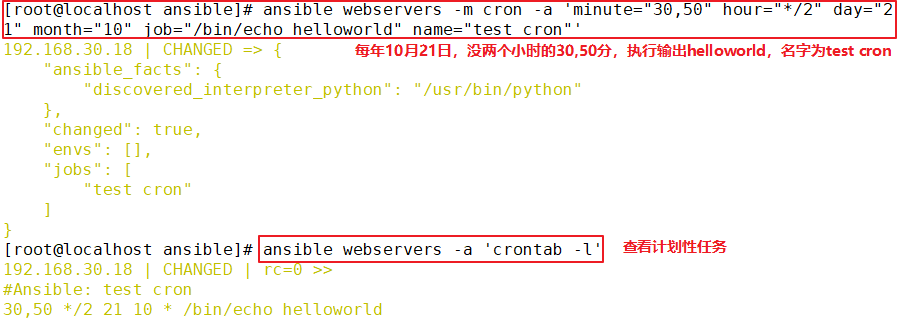

user module
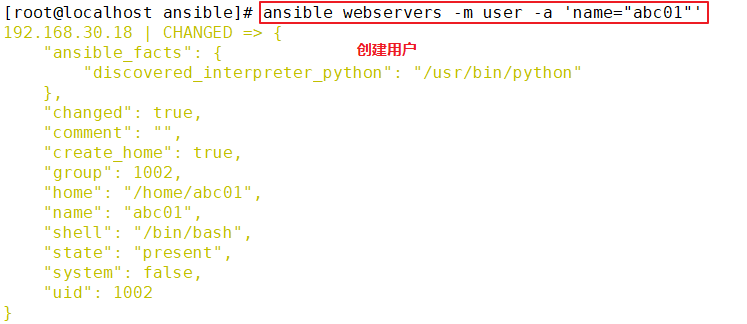

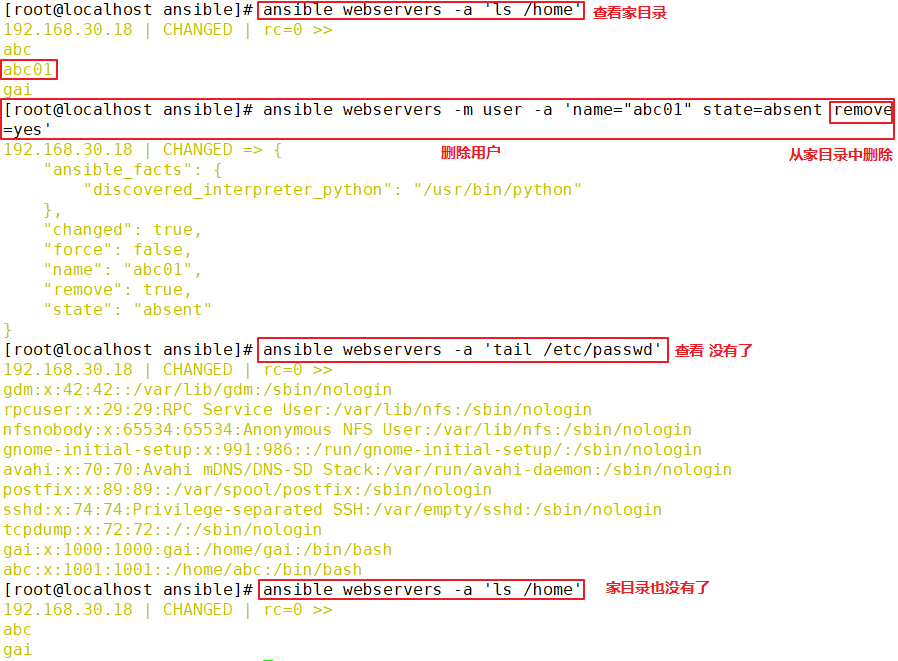
group module

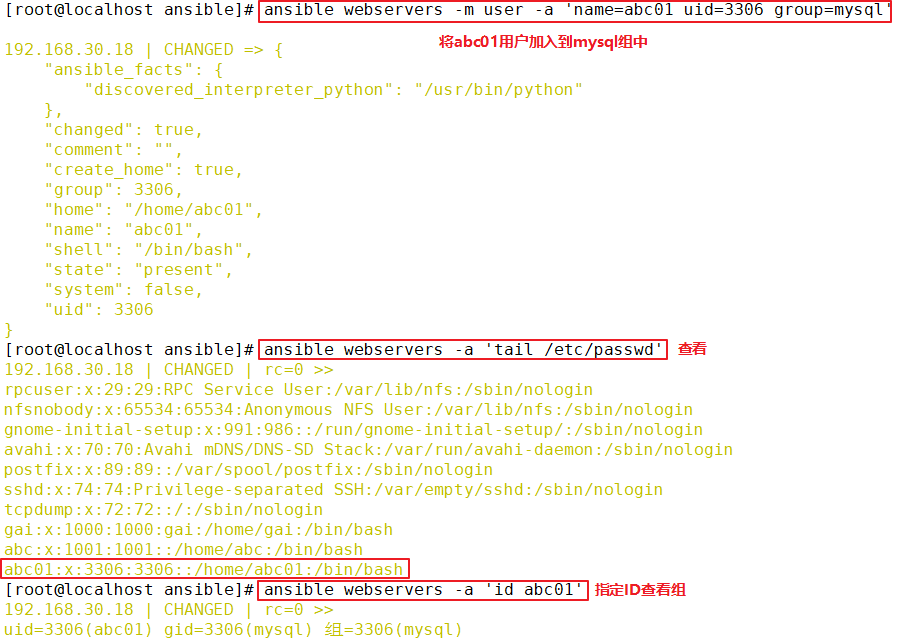
copy module
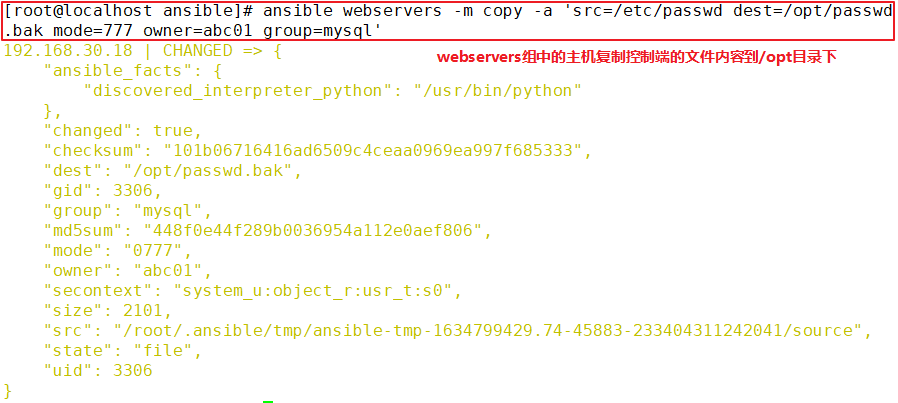
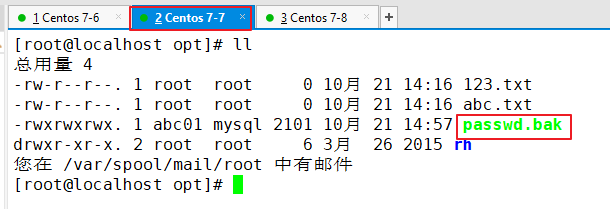
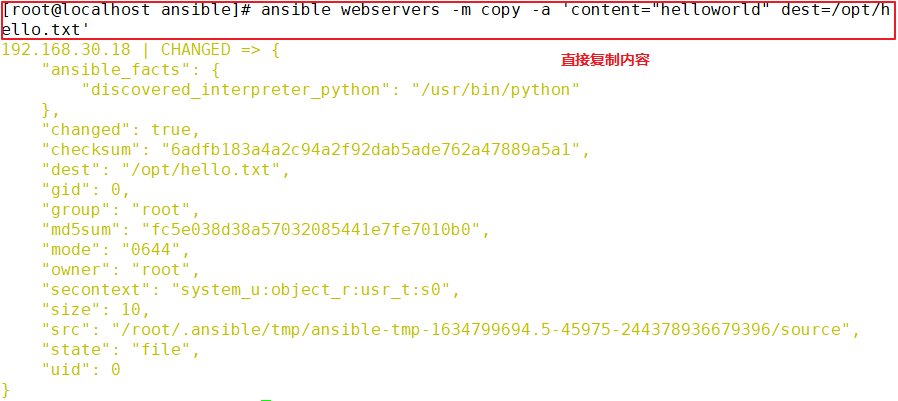

file module
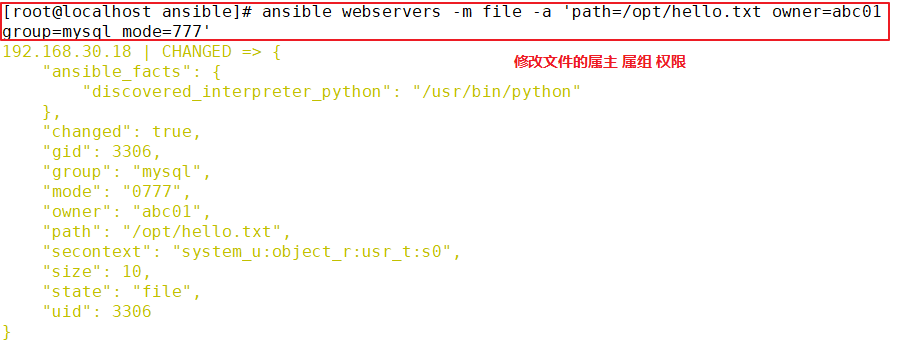





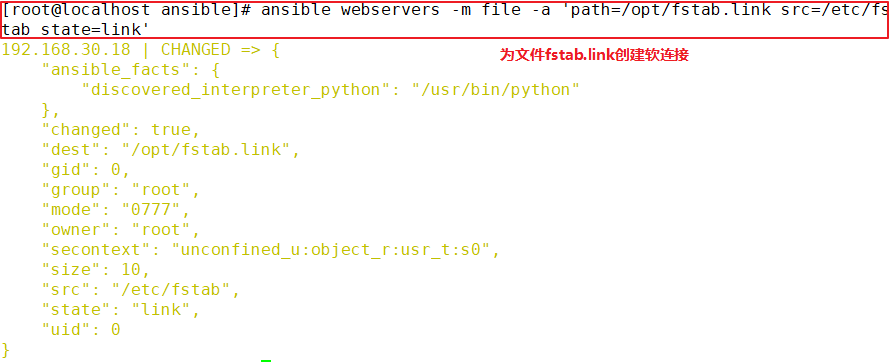

hostname module
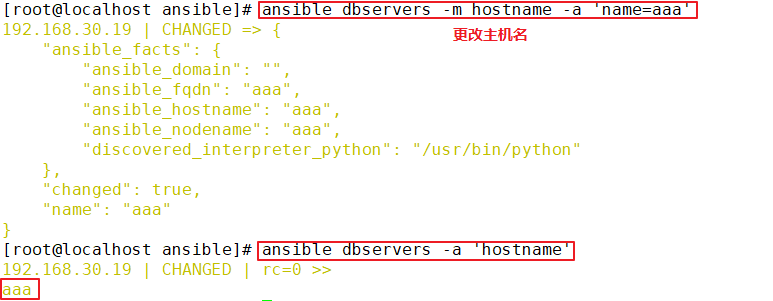

ping module
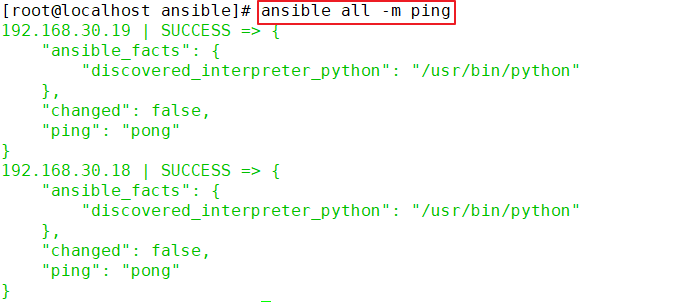
yum module

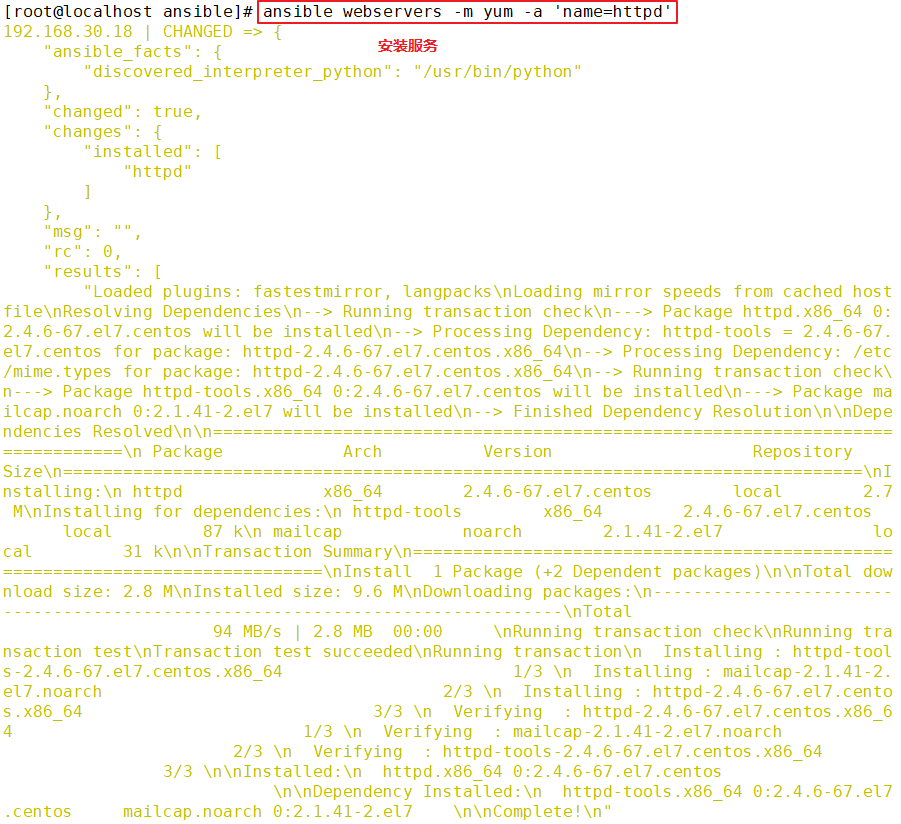

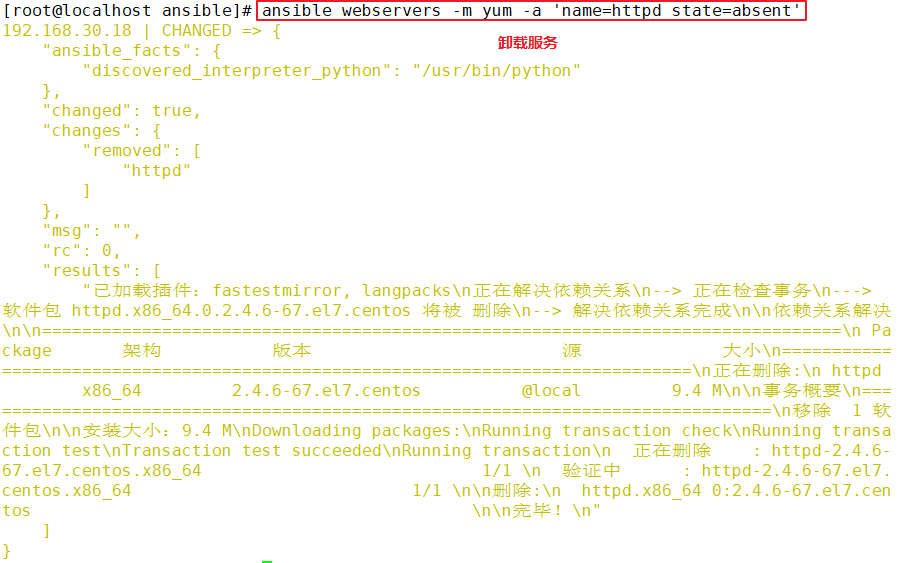

service/systemd module
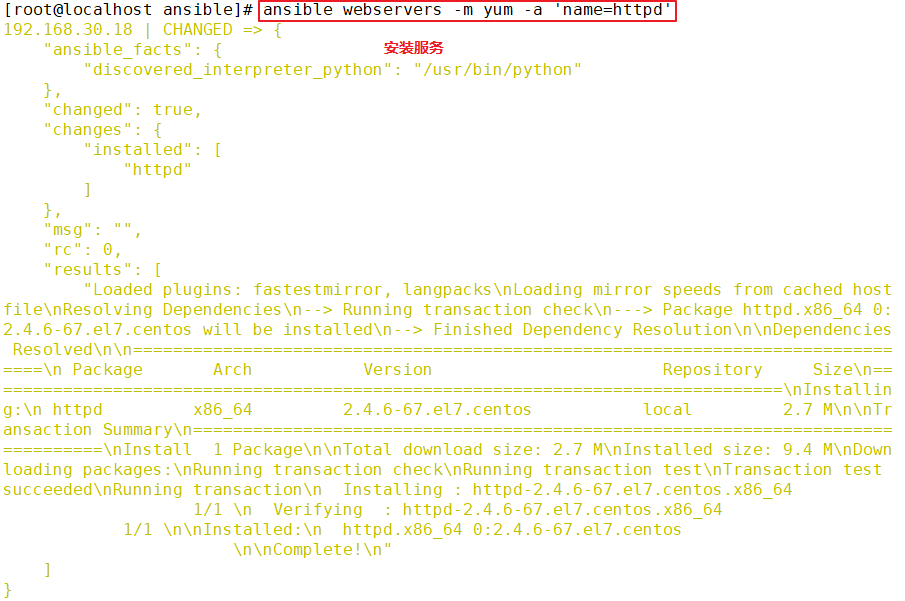

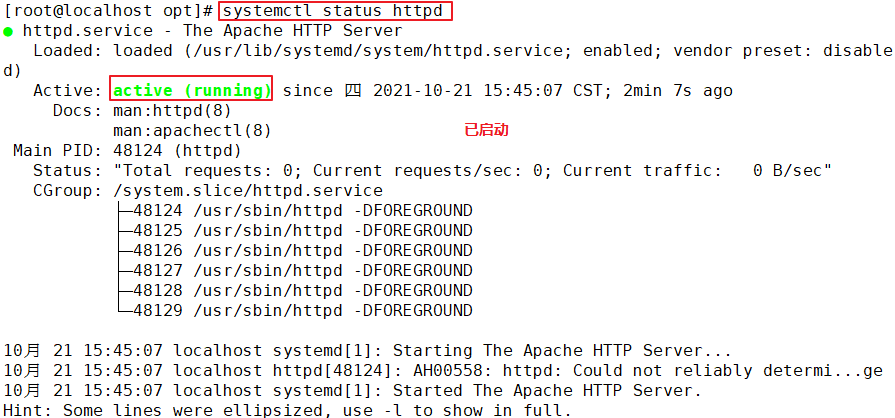



script module



setup module
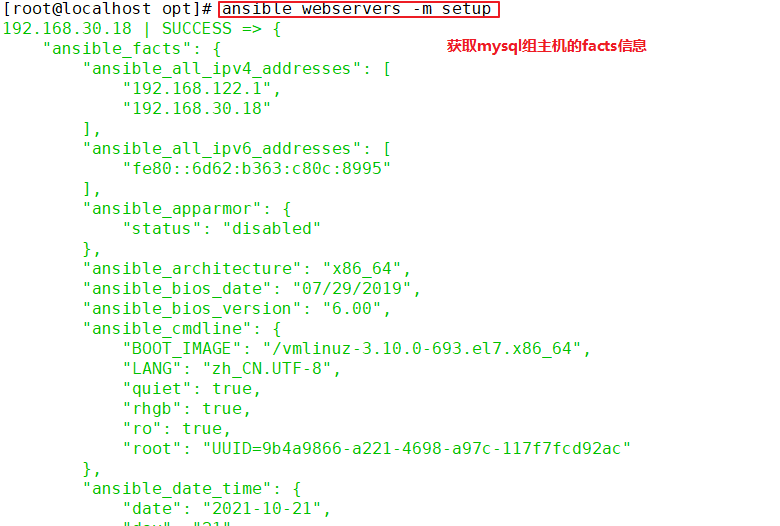
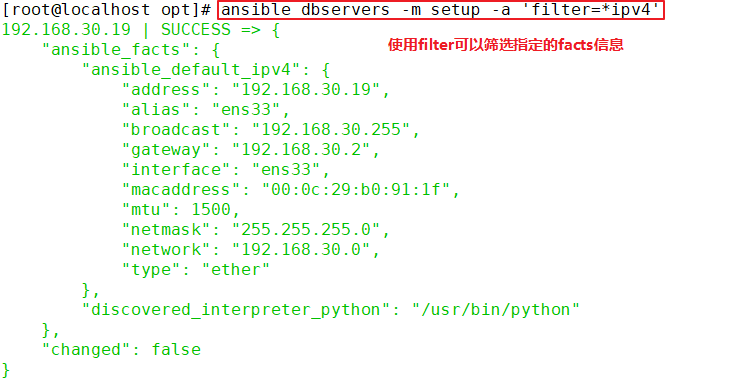
4, inventory host list
--------- inventory Host list --------- //Inventory supports grouping hosts. Multiple hosts can be defined in each group, and each host can be defined in any one or more host groups. //If you are a host with a similar name, you can use a list to identify each host. vim /etc/ansible/hosts [webservers] 192.168.30.18:2222 #The remote connection port is defined after the colon. The default is port 22 of ssh 192.168.30.1[2:5] [dbservers] db-[a:f].example.org #Support matching a~f //Variables in inventory Inventory Variable name meaning ansible_host ansible When connecting nodes IP address ansible_port The port number of the other party, ssh The default value is 22 when connecting ansible_user The host name used when connecting to the other host. When not specified, execution is used ansible or ansible-playbook User of the command ansible_password The name of the user at the time of connection ssh Password, valid only without key pair authentication ansible_ssh_private_key_file Specify key authentication ssh Private key file at connection time ansible_ssh_common_args provide for ssh,sftp,scp Additional parameters for the command ansible_become Allow privilege escalation ansible_become_method Specify how permissions are elevated, for example, by using sudo/su/runas Other ways ansible_become_user Which user's permission is promoted to? The default is promoted to root ansible_become_password Password when promoted to the specified user rights (1)Host variable [webservers] 192.168.30.18 ansible_port=22 ansible_user=root ansible_password=abc1234 (2)Group variable [webservers:vars] #Represents a variable defined for all hosts in the webservers group ansible_user=root ansible_password=abc1234 [all:vars] #Represents a variable defined for all hosts in all groups ansible_port=22 (3)Group nesting [nginx] 192.168.30.20 192.168.30.21 192.168.30.22 [apache] 192.168.30.3[0:3] [webs:children] #Indicates that the web host group contains all hosts in the nginx group and apache group nginx apache